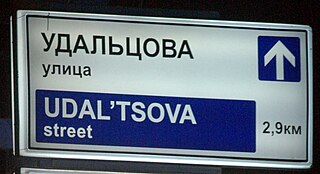Transliteration is a type of conversion of a text from one script to another that involves swapping letters in predictable ways, such as Greek ⟨α⟩ → ⟨a⟩, Cyrillic ⟨д⟩ → ⟨d⟩, Greek ⟨χ⟩ → the digraph ⟨ch⟩, Armenian ⟨ն⟩ → ⟨n⟩ or Latin ⟨æ⟩ → ⟨ae⟩.

In linguistics, romanization is the conversion of text from a different writing system to the Roman (Latin) script, or a system for doing so. Methods of romanization include transliteration, for representing written text, and transcription, for representing the spoken word, and combinations of both. Transcription methods can be subdivided into phonemic transcription, which records the phonemes or units of semantic meaning in speech, and more strict phonetic transcription, which records speech sounds with precision.
In computing, a code page is a character encoding and as such it is a specific association of a set of printable characters and control characters with unique numbers. Typically each number represents the binary value in a single byte.
ISO 9 is an international standard establishing a system for the transliteration into Latin characters of Cyrillic characters constituting the alphabets of many Slavic and non-Slavic languages.

The romanization of the Russian language, aside from its primary use for including Russian names and words in text written in a Latin alphabet, is also essential for computer users to input Russian text who either do not have a keyboard or word processor set up for inputting Cyrillic, or else are not capable of typing rapidly using a native Russian keyboard layout (JCUKEN). In the latter case, they would type using a system of transliteration fitted for their keyboard layout, such as for English QWERTY keyboards, and then use an automated tool to convert the text into Cyrillic.
The romanization of Ukrainian, or Latinization of Ukrainian, is the representation of the Ukrainian language in Latin letters. Ukrainian is natively written in its own Ukrainian alphabet, which is based on the Cyrillic script. Romanization may be employed to represent Ukrainian text or pronunciation for non-Ukrainian readers, on computer systems that cannot reproduce Cyrillic characters, or for typists who are not familiar with the Ukrainian keyboard layout. Methods of romanization include transliteration and transcription.
The Royal Thai General System of Transcription (RTGS) is the official system for rendering Thai words in the Latin alphabet. It was published by the Royal Institute of Thailand in early 1917, when Thailand was called Siam.

The Hebrew language uses the Hebrew alphabet with optional vowel diacritics. The romanization of Hebrew is the use of the Latin alphabet to transliterate Hebrew words.
Ayin is the sixteenth letter of the Semitic scripts, including Arabic ʿaynع, Aramaic ʿē 𐡏, Hebrew ʿayinע, Phoenician ʿayin 𐤏, and Syriac ʿē ܥ.
The international standard ISO 233 establishes a system for romanization of Arabic script. It was supplemented by ISO 233-2 in 1993 which is specific for Arabic language.

The romanization of Arabic is the systematic rendering of written and spoken Arabic in the Latin script. Romanized Arabic is used for various purposes, among them transcription of names and titles, cataloging Arabic language works, language education when used instead of or alongside the Arabic script, and representation of the language in scientific publications by linguists. These formal systems, which often make use of diacritics and non-standard Latin characters and are used in academic settings or for the benefit of non-speakers, contrast with informal means of written communication used by speakers such as the Latin-based Arabic chat alphabet.
ISO 259 is a series of international standards for the romanization of Hebrew characters into Latin characters, dating to 1984, with updated ISO 259-2 and ISO 259-3.
Scientific transliteration, variously called academic, linguistic, international, or scholarly transliteration, is an international system for transliteration of text from the Cyrillic script to the Latin script (romanization). This system is most often seen in linguistics publications on Slavic languages.
There are many systems for the romanization of the Thai language, i.e. representing the language in Latin script. These include systems of transliteration, and transcription. The most seen system in public space is Royal Thai General System of Transcription (RTGS)—the official scheme promulgated by the Royal Thai Institute. It is based on spoken Thai, but disregards tone, vowel length and a few minor sound distinctions.

The Latin script, also known as the Roman script, is a writing system based on the letters of the classical Latin alphabet, derived from a form of the Greek alphabet which was in use in the ancient Greek city of Cumae in Magna Graecia. The Greek alphabet was altered by the Etruscans, and subsequently their alphabet was altered by the Ancient Romans. Several Latin-script alphabets exist, which differ in graphemes, collation and phonetic values from the classical Latin alphabet.
An IETF BCP 47 language tag is a standardized code that is used to identify human languages on the Internet. The tag structure has been standardized by the Internet Engineering Task Force (IETF) in Best Current Practice (BCP) 47; the subtags are maintained by the IANA Language Subtag Registry.

Romanization or Latinization of Persian is the representation of the Persian language with the Latin script. Several different romanization schemes exist, each with its own set of rules driven by its own set of ideological goals.

Semitic romanization is the process by which Semitic languages are transliterated into the Latin alphabet. The Semitic languages emerged in the Middle East during prehistory. Contemporary Semitic languages are almost all natively written in various abjads or alphabets such as the Arabic, Amharic, and Hebrew scripts. A notable exception is Maltese, which is the only Semitic language with a standard native form written in the Latin script.
ISO 11940 is an ISO standard for the transliteration of Thai characters, published in 1998 and updated in September 2003 and confirmed in 2008. An extension to this standard named ISO 11940-2 defines a simplified transcription based on it.
ISO 11940-2 is an ISO standard for a simplified transcription of the Thai language into Latin characters.